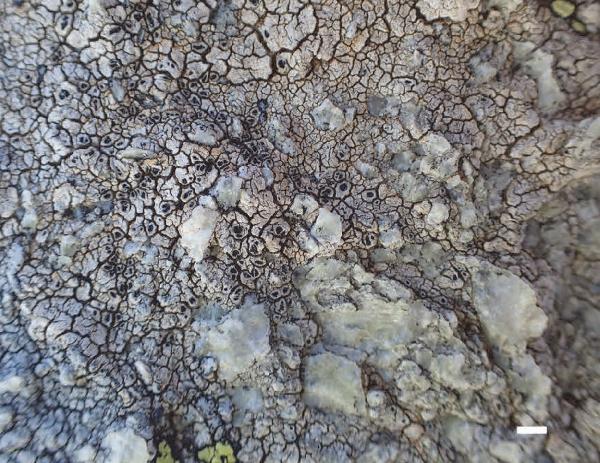Aspicilia inornata Arnold
Verh. zool.-bot. Ges. Wien, 27: 550, 1877.
Synonyms:
Distribution: N - Ven, TAA, VA (Piervittori & Isocrono 1999). C - Tosc (TSB 10470), Sar.
Description: Thallus crustose, episubstratic, rimose-areolate, <0.5 mm thick, the areoles smooth, flat to slightly convex, 0.5-0.7 mm wide, ochraceous white, whitish grey or pale lead-grey, forming large patches, with or (usually) without a dark prothallus. Cortex paraplectenchymatous, indistinctly delimited, (20-)30-40(-50) µm thick formed by 3-5 µm wide polygonal cells, rich in large crystals insoluble in N and small crystals soluble in N; medulla white, filled by crystals resembling those of the cortex, I-; algal layer not extending below the hypothecium. Apothecia lecanorine-aspicilioid, immersed in the areoles, 1-3 per areole, (0.2-)0.3-0.6(-0.7) mm across, usually irregular in outline, with a concave to flat, black, epruinose disc, a thin, black proper margin, and a thick but not prominent, dark thalline margin. Proper exciple wider and paraplectenchymatous in upper part, the outer terminal cells capitate and dark-capped; epithecium greenish to olive-brown, 10-20 µm high, N+ emerald green; hymenium colourless, (100-)120-140(-150) µm high, I- or I+ yellowish brown; paraphyses coherent, submoniliform in upper part, the apical cells 3-4.5 µm wide; hypothecium colourless, 40-50 µm high, I+ blue. Asci (6-)8-spored, clavate, the thin outer coat K/I+ blue, the wall and apical dome K/I-. Ascospores 1-celled, hyaline, ellipsoid to broadly ellipsoid, 17-24(-27) x (8-)10-12(-15) µm. Pycnidia immersed, with a black to brown, punctiform ostiole and a pale wall. Conidia bacilliform, straight 6-7 x 0.8-1 µm. Photobiont chlorococcoid. Spot tests: cortex and medulla K-, C-, KC-, P-. Chemistry: without lichen substances.Note: on periodically submerged schistose rocks along brooks in upland areas; most frequent in the Alps. According to Roux & coll. (2014) records from lowland areas are due to confusion with other species.
Growth form: Crustose
Substrata: rocks
Photobiont: green algae other than Trentepohlia
Reproductive strategy: mainly sexual
Periodically submerged (e.g. in creeks)
Commonnes-rarity: (info)
Alpine belt: very rare
Subalpine belt: very rare
Oromediterranean belt: extremely rare
Montane belt: very rare
Submediterranean belt: absent
Padanian area: absent
Humid submediterranean belt: absent
Humid mediterranean belt: absent
Dry mediterranean belt: absent

Predictive model
Herbarium samples
Growth form: Crustose
Substrata: rocks
Photobiont: green algae other than Trentepohlia
Reproductive strategy: mainly sexual
Periodically submerged (e.g. in creeks)
Commonnes-rarity: (info)
Alpine belt: very rare
Subalpine belt: very rare
Oromediterranean belt: extremely rare
Montane belt: very rare
Submediterranean belt: absent
Padanian area: absent
Humid submediterranean belt: absent
Humid mediterranean belt: absent
Dry mediterranean belt: absent

Predictive model
| Herbarium samples |
 INDEX FUNGORUM
INDEX FUNGORUM
 GBIF
GBIF
 DOLICHENS
DOLICHENS


